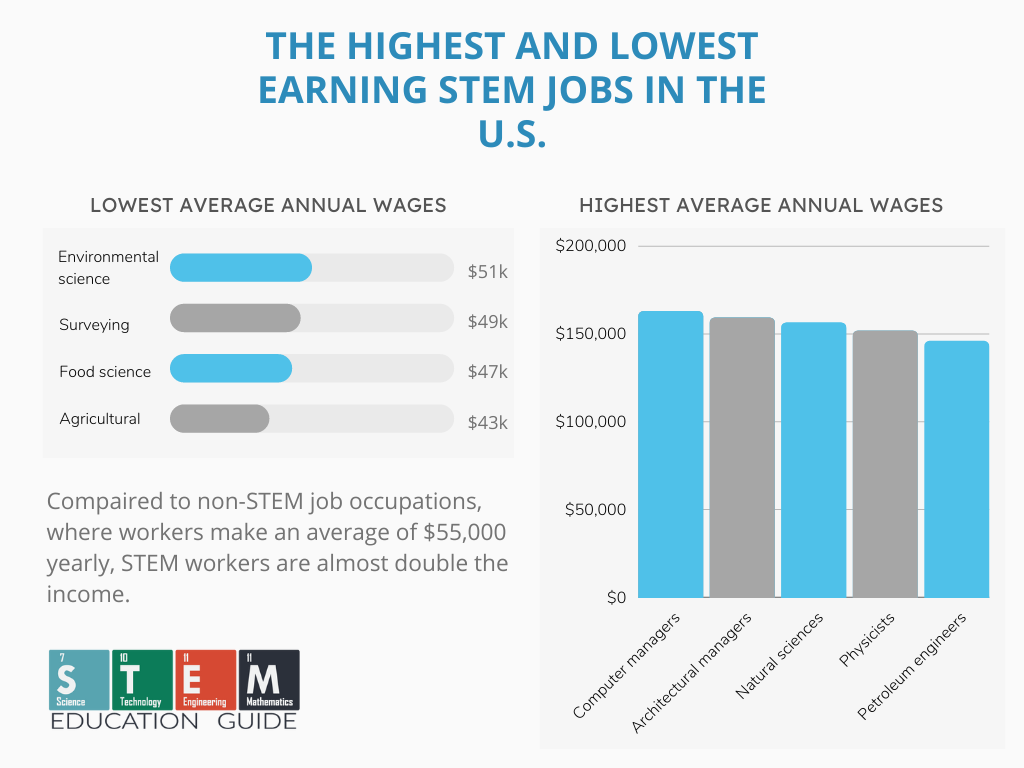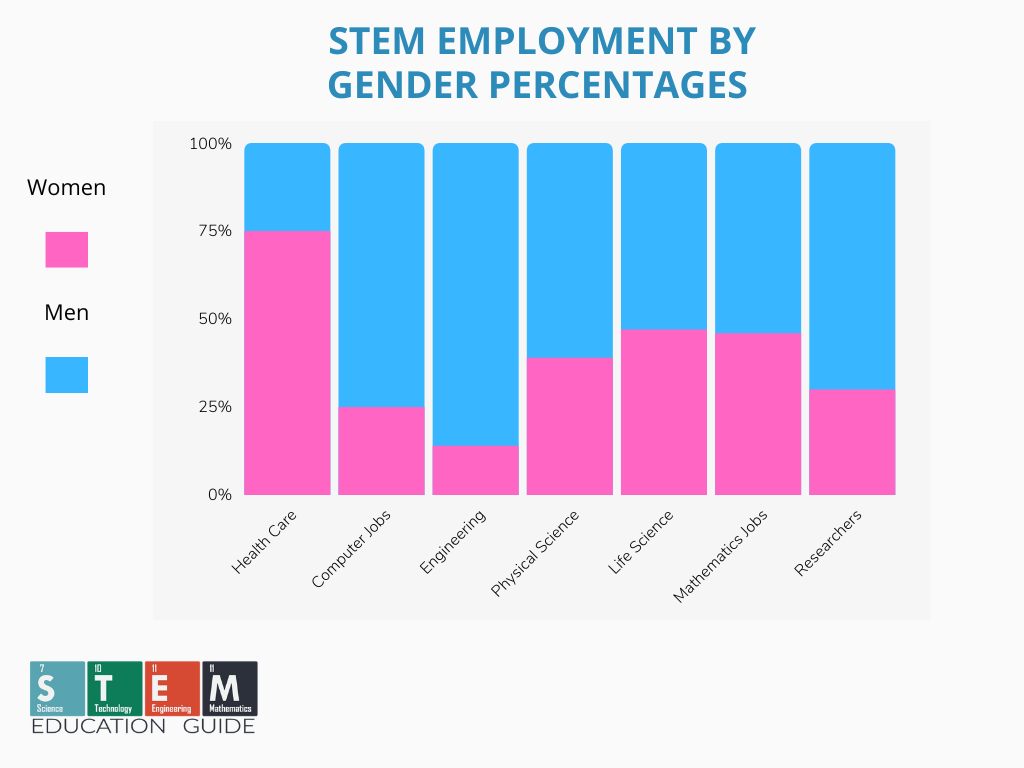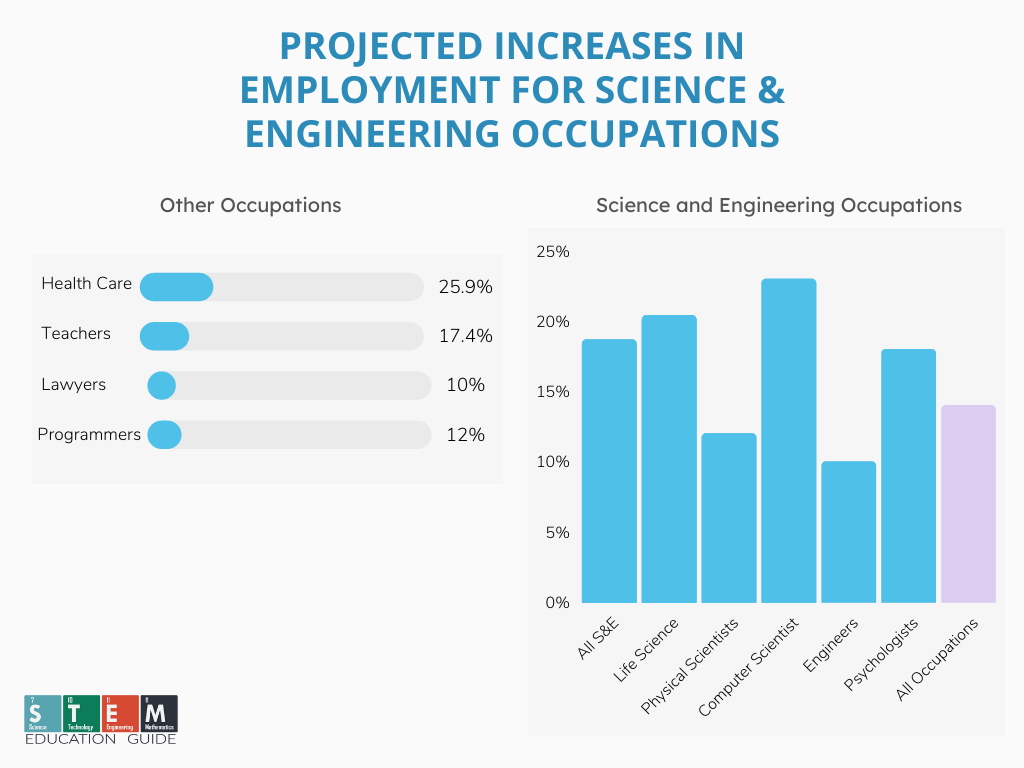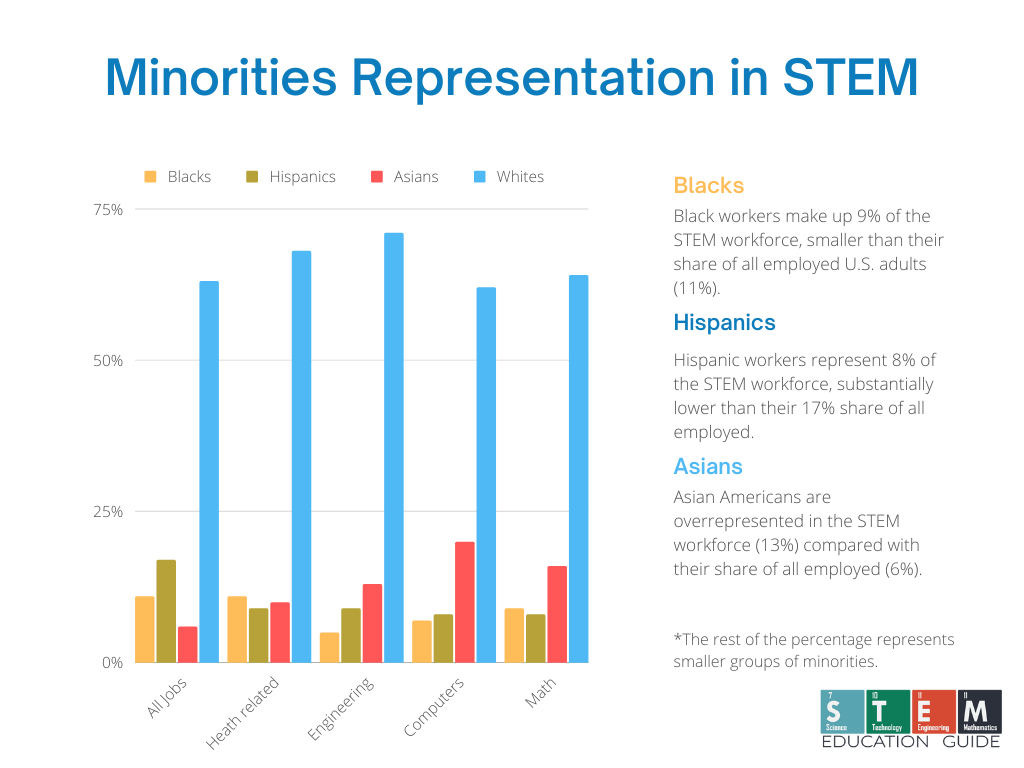We’ve gathered the most interesting, informative facts and statistics about STEM education.
STEM stands for Science, Technology, Engineering, and Mathematics. STEM is the interconnection between these topics.
Table of Contents
STEM Education Statistics

The average salary for all STEM workers is $100,900
Depending on where you live, this might seems below average for a college education. Compaired to other non-STEM job occupations where workers make an average of $55,000 a year, STEM workers are doing well, almost double the income.
Computer System Managers Make the Most
The average STEM worker makes just over $100k, and computer system managers raise this average by making the most income out of every STEM field.

Looking at this information, we can see that STEM occupations at all levels offer competitive wages and the best opportunities for career advancement.
The Average Median Hourly Wage for STEM Jobs
The average median hourly wage for STEM jobs is $38.85. This number is constantly changing, especially during these times, but it’s much higher than the median earnings for all other types of jobs in the US – $19.30.
The USA is only 38th of 71 countries in Math and 24th in Science
This statistic is from Programme for International Student Assessment (PISA). This is regarded as one of the most extensive worldwide tests to measure students’ math and science knowledge.
Most High school Students Are Not Ready to Take College Level Science Courses
According to the National Math and Science Initiative, only 36% of students are ready for college-level science courses.
More High School Students Are Ready for More Advanced Math Than Science
While only 36% of students are ready for college science, 44% of high school students are prepared for college-level math.
Women in STEM Education Statistics

While researching for this article, learning about how women are represented in STEM was the most surprising. I would have never thought the gap between men and women was so significant in specific STEM careers.
Girls Are Most Interested in STEM During Middle School, but It Drops Off As They Get Into High School
This survey was conducted in Europe. It found that girls’ interest in STEM peaked at age 11 and started to drop off after that.
Women Have Seen an Increase in Science-Related Jobs
Women comprise 48% of all the workers in life sciences. This is a major increase of 34% since the 90s.
Besides Science, Women Haven’t Seen Much Increase
While women have 48% of all the life science jobs, in other STEM job clusters such as engineering, women have only slightly increased in these careers.
Men dominate engineering, and women only represent 15% of all the engineers in the US.
Women Earn Less Than Men in the Same Field
Women are overrepresented at 75% of healthcare practitioners and technicians in the healthcare industry, but women earn 77% of the average salary of men. Women close the gap somewhat in computer jobs with as much as 81% of what men make.

Minority Women Are Underrepresented in STEM
Women are underrepresented in STEM, but minority women represent the largest minority in STEM fields. 3% black and only 4% Latin women graduate with a doctorate. Unsurprisingly, only 1 out of 20 employed scientists and engineers are black women or Latinas.
STEM Workforce Statistics

As STEM combines multiple disciplines in real-world applications, it transforms our workforce. These workforce and STEM job growth statistics shine a light on this transformation.
Over 10 Million People Work in STEM
As of 2020, over 10.2 million people work in a STEM field in the US. This represents 6.6% of all the jobs in the US. If this trend continues, 11.3 million people in the US will work in STEM by 2030 as STEM will continue to grow fast.
What STEM Fields Have the Most Growth
The number of STEM jobs is projected to grow eight percent, which is a higher rate than non-STEM jobs that have reminded steady or slightly decided this year.
Combined with the growth of STEM occupations that has grown 79% since 1990, a STEM education program is more important than ever.
Top Three STEM Sectors
When you mention STEM or careers on the rise, people often think of computers or Silicon Valley. The truth is the fastest rising jobs in STEM are in healthcare, with 25.9% growth between 2010 and 2020.
Technology is still on the rise, but it’s just behind at 23.1% of growth for the same period. Environmental-related jobs are right behind at a 20.1% growth year over year this past decade.
—–Please join us in our article, Is Nursing STEM? Here’s What You Need to Know!—–
STEM Will Bring New Unheard of Jobs
As technology progresses, new jobs fill roles unheard of before. Just a few years ago, a job title such as a Big Data engineer was unheard of, ten years, new jobs will need to be filled that previously didn’t exist.
According to Dell, professionals believe that 85% of STEM jobs don’t exist yet that will be needed in 2030.

STEM Jobs Total 6.2% of Jobs
With 8.6 million jobs in STEM, it represents 6.2% of the total workforce in the US. Computer occupations represent the most significant percentage of these jobs at 43%.
Minorities in STEM Statistics

STEM fields feature a diverse group of people from all over the world. Some groups are not represented in relation to the workforce as a whole. In this section, we have some facts about minorities in the job market. Keep in mind that Black Americans comprise 13.4% of the general population.
Black and Hispanic Workers Are Underrepresented in STEM Jobs
Black workers make up 11% of the employed US workforce. In the STEM workforce, Blacks only make up 9%.
The majority of Blacks in a STEM field are in healthcare-related jobs. The most underrepresented area for Blacks is engineering and architecture, at 5%.

71% of Engineers are White
Engineering is the most extensive area we could find that is dominated by one race. In this statistic, engineering also includes architects.
Blacks and Hispanics Receive the Least Amount of STEM-Related Degrees
Black students earned only 7% of STEM degrees but received 10% of the total degrees in the US for the same period.
Hispanics earned 10% of the STEM degrees and 15% of the bachelor’s degrees in all fields.
Not That Many Black Students in Computer Science
Only 8.6% of computer science graduates are black. This is the lowest rate compared to other races and ethnicities. Black men have the lowest completion rate at 40%.
STEM Jobs for Minorities Are Increasing
While minorities represent a smaller percentage in STEM occupations, the numbers are increasing. Works grew from 3% in 1995 to 8% in 2019, and holding their highest degree in science and engineering fields rose from 3% to 9%.
—–If there is one area of education filled with accusations of being inadequate in the US, it would be STEM. In our article, we go over everything that’s wrong with STEM education.—–
STEM in Early Education Statistics

Our site has been dedicated to early education in STEM for years. It’s nice to see STEM get a foothold in early education as it’s shown to be very beneficial for children to focus on Science and technology from an early age.
After School Education is Positive
80% of students say their STEM career knowledge increased because of their afterschool experience. This allows students to focus on the subjects they are most interested in.
Young Kids Have a Better Attitude Towards Stem When Volunteering Their Time
78% of students said they had a more positive attitude about STEM because of their afterschool experience. Most students volunteered their time to stay after school for these classes.
Computer Science Is the Most Popular Among Young Students
Afterschool STEM programs focus on computer science. 1% of afterschool participants have access to computer science in their program. His is positive as computer science also represents the majority of STEM jobs.
As STEM education is built around a practical approach to studying, this fact shows that the priority of computer science is highly beneficial for kids.
Not Enough Kids Are Proficient in Math and Science
A strong and early foundation in STEM has a lifelong benefit for kids’ education. Not every kid is receiving this opportunity, though.
Studies have shown that only 66% of fourth graders are not proficient in Science. His study also shows that 60% were also not proficient in math as well.
Encouraging Kids to Pursue Stem Has Lifelong Effects
We’ve covered why STEM is crucial and the projected job growth in STEM fields. Studies have shown that encouraging kids to pursue a STEM field gives them an advantage when they are adults that they wouldn’t receive if they didn’t start early.
Global STEM Statistics

This article has been chiefly focused on STEM education statistics in the US. Worldwide STEM statistics and trends are interesting as well.
Percent of Graduating Students in Europe
In the 27 countries of the European Union, 25.8% of students graduated in STEM subjects. The county with the most students in STEM was Germany.
European Country With the Least About of Students in STEM
While not surprising that Germany has the most students graduating in a STEM field, Cyprus had the least at less than 20%. Cyprus’s population is only 1.3 million residents.
Highest Percentage of University Graduates in Proportion to Size
Germany, with the most graduating students, doesn’t tell the whole story. The highest percentage of graduates is in Ireland at 9%.
Women in Europe Are Not Becoming Scientists
Women worldwide are underrepresented in STEM, the same as in the US. n Europe, less than 30% of the researchers are women. Compared to the US, where 59% of scientists are women.
Eastern Europe Have More Women in STEM
In Eastern Europe, 39.3% of researchers across STEM fields were female, while in Western Europe, it was only 32.7%.
US vs. World STEM Statistics

We’ve looked at the US and European countries’ STEM data. Now let’s see how they compare with the rest of the world.
What Country Leads in STEM Graduates
The US used to lead for years, and India had the mo t graduates of any country worldwide with 78.0 million. China was right behind India with 77 million. The US had 67.4 million graduates.
China Builds the Most Universities
China was building the equivalent of one Univerity a week. While this was in 2016, it’s still a fantastic amount of universities.
Acceleration of Growth
Not surprisingly, as China is building so many schools, it also has the fastest increase in graduates at a growth rate of 300%. Europe is also increasing but only at a rate of 30%.
It’s not just the number of students. Chinese students are more likely to study mathematics and Science than American students.
The Future of STEM
China and India are betting big on STEM. Studies have shown by 2030, China and India will le d in a big way. They could account for more than 60% of the STEM graduates. This is compared to only 8% in Europe and 4% in the United States.
The US Is Lagging, and the Gap Is Widening
For middle school students (ages 11 to 13), the US ranked eleventh among the forty-six participating education systems. The countries in the lead were Singapore, China, South Korea, Japan, and Russia.
—–In our article, STEM vs. STEAM, we discuss the differences between the two and their relationship together.—–











